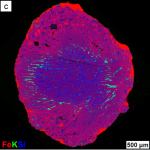About Sarah Crowther
I'm a Post Doc in the Isotope Geochemistry and Cosmochemistry group. I study xenon isotope ratios using the RELAX mass spectrometer, to try to learn more about the origins and evolution of our solar system. I look at a wide range of samples from solar wind returned by NASA's Genesis mission to zircons (some of the oldest known terrestrial rocks), from meteorites to presolar grains.
This gallery contains 1 photo.
Congratulations to Jonathan Lewis who has won the 2019 Nininger Meteorite Award for student research papers. The award recognizes outstanding student achievement in the meteoritical sciences, as embodied by an original research paper. Jonathan completed his PhD at the University of … Continue reading →
More Galleries
|
Tagged chondrules, electron microscopy, Jonathan Lewis, Meteorites, Nininger Meteorite Award, PhD, Porosity, Rhian Jones, Saratov, University of New Mexico, X-ray microtomography
|
This gallery contains 1 photo.
This post was written by Prof Jamie Gilmour Around 4.5 billion years ago the sun formed when part of a huge cloud of gas and dust began to collapse. If you could go back in time at look at what … Continue reading →
This gallery contains 1 photo.
This post was written by Prof Jamie Gilmour We understand that systems of planets form alongside their parent stars. Part of a rotating cloud of gas and dust collapses to form a rotating disk. Most of the material is eventually … Continue reading →
This gallery contains 1 photo.
We would like to invite you to join us, the Royal Astronomical Society and the organising committee of the European Lunar Symposium for an exciting talk about the Moon with NASA’s Chief Scientist: The Importance of the Moon: Past, Present, … Continue reading →
This gallery contains 1 photo.
Just a quick post to let you know that we’re branching out into the world of Instagram – so if you like pictures of rocks, space rocks, and general earth and planetary science related goodness why not checkout our new … Continue reading →
Its mid-March, and we all know what that means… It is almost time for the 49th Lunar and Planetary Science Conference (LPSC), which will be taking place in The Woodlands, Texas next week. Work by several members of our research … Continue reading →
This gallery contains 14 photos.
We got a Lego Saturn V! Like a bunch of 14 year old kids (more like a bunch of 5 year old kids, but the box said suitable for ages 14+!) we’ve been excitedly building it one bag at a … Continue reading →
This gallery contains 2 photos.
Red or blue? Its an important question here in Manchester*, and the answer can never be both! However it seems if you’re the Moon you can be red and blue at the same time! But I don’t think that results … Continue reading →
This gallery contains 2 photos.
This article was written by group member Dr Greg Holland, Senior Lecturer in Terrestrial Noble Gas Geochemistry ———— ———— ———— New group paper: Tracing ancient hydrogeological fracture network age and compartmentalisation using noble gases Very little is understood about the … Continue reading →
This gallery contains 1 photo.
This article was written by group member Dr Greg Holland, Senior Lecturer in Terrestrial Noble Gas Geochemistry ———— ———— ———— New group paper: Estimating carbon dioxide residence time scales through noble gas and stable isotope diffusion profiles. One potential way … Continue reading →










